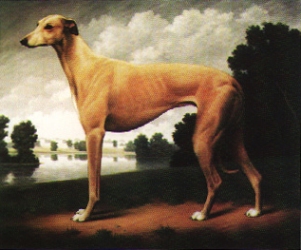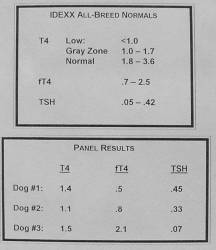HYPOTHYROIDISM IN GREYHOUNDS

Christine Merrill
Greyhound in a Parkland Landscape
Image courtesy Barewalls.com
Suzanne Stack, DVM
The paired thyroid glands are located in
the upper part of the neck beside the trachea (windpipe). When
stimulated by the hormone TSH (thyroid stimulating hormone) produced
by the brain's pituitary gland, the thyroid glands produce and
release thyroid hormones (T3 & T4) into the bloodstream. Thyroid
hormones are important in many areas of body metabolism. Thyroid
deficiency (hypothyroidism) most commonly results in dermatologic
disorders, reproductive abnormalities, lethargy and mental dullness,
obesity. slow heart rate (normal in our greyhound athletes), and
less commonly, muscle and nerve dysfunction.
Hypothyroidism is one of the most
over-diagnosed conditions in veterinary medicine and is a scapegoat
for conditions as diverse as lethargy and hyperactivity, shyness and
aggression. While any of these manifestations is possible,
hypothyroidism is far from the answer to everything. Every owner of
every fat dog wants to "fix it" with thyroid pills. Similarly,
veterinarians pray for a hypothyroid diagnosis to explain every
non-responsive skin case.
The difficulty in diagnosing
hypothyroidism in greyhounds is twofold:
1) There are inherent imperfections in
measuring T4 levels.
2) Normal greyhound T4s are lower than
those in the general canine population.
The diagnosis of hypothyroidism should
be based on the correlation of abnormally low thyroid function tests
combined with a clinical history compatible with hypothyroidism.
"Low" T4s in the absence of clinical signs are useless and many a
greyhound winds up on unnecessary lifelong Soloxine.
A study by Bloomberg at the University
of Florida measured T4s in 221 greyhounds who had been prescreened
for other endocrinopathies. They ranged in age from 11 months to 10
years. The T4 range was .5 - 3.6, with a mean of 1.47. Of 221
greyhounds, 48 had T4s below 1.0. Keep in mind that most commercial
diagnostic labs consider these normal greyhound means, borderline to
low.
The breakdown was:
Mean T4
97 in training
or racers 1.53
99 brood
bitches 1.56
25 stud dogs
.94
221 total
1.47
It was theorized that the lower T4s
among studs might be because T4 concentrations tend to decrease with
older age in canines.
These findings correlate well with an
article in the Februarv, 2000 issue of "Veterinary Medicine",
(Common Skin Diseases in Greyhounds), which gives a greyhound normal
T4 range of .7 - 3.6.
Little emphasis is placed on T3 as a
diagnostic tool for canine hypothyroidism, but both these sources
show higher T3s for greyhounds vs. other dogs.
While T4 is the standard hypothyroid
screening test, Many extraneous factors can suppress T4 including
anorexia, sickness, and a variety of drugs, most importantly
steroids, sulfas and seizure medications. "Sick euthyroid" refers to
the common condition where the dog has normal thyroid function but
illness lowers the T4. These dogs do not require Soloxine. It is
unknown if the extreme stresses of racing, travel, and dense kennel
populations may also play a role in thyroid gland function.
If there is concurrent illness, the T4
will be low and it doesn't mean a thing (sick euthyroid). Therefore,
the ideal situation with new adoptees is resolving health problems
first, then testing once the greyhound is healthy and has been off
the track six months or more. Though six months isn't written in
stone, it is ample time for poor haircoats/bald thighs to re-grow
and for "spooks" to show their true colors.
if after a reasonable time period and
return to health, there are still clinical signs and a low T4, a
free: T4 (fT4) by equilibrium dialysis and TSH are recommended. ff4
by equilibrium dialysis (be sure this is the method used) is
essentially a T4 reading that's less influenced by extraneous
factors. TSH is a compromise to actual TSH stimulation, which is
considered the "gold standard" in thyroid testing, but is not widely
available. With all of these, it is imperative not to heparinize the
red top tube the sample is collected in.
This may seem like a lot of testing and
a waste of money to some, but it's very simple (a blood draw) and
beats keeping a greyhound unnecessarily on Soloxine forever on the
basis of one "low" T4.
A simplistic explanation of TSH is that
if your greyhound is truly low on T4, the pituitary responds by
cranking out TSH by the boatload -- essentially screaming "Make,
more T4!" While TSH isn't a perfect test either, the combination of
T4, ff4, and TSH gives you a much better assessment than just a T4.
If T4 is borderline and TSH is on the low side, the dog is unlikely
to be hypothyroid. But, if T4 is borderline and TSH is high or at
least towards the high end of normal, it's cause to try Soloxlne.
The chart below compares panels run on
three different dogs with the T4, fT4 and TSH using All-breed
“normal" standards set by IDEXX Lab.

Conclusions:
Dog #1 -
hypothyroid
Dog #2 -
Suspicious, try Soloxine.
Dog #3 - Sorry,
not hypothyroid, just fat!
Finally, if you just cannot tell from
blood tests, often the best test is a 6-week trial on Soloxine. If
signs resolve, there's your answer. If his thighs stay bald, please
don't leave him on Soloxlne forever. Bald thigh syndrome in
greyhounds is as yet of uncertain etiology, some respond to
Soloxine, some don't. If you're just not sure it helped, stop the
Soloxine in 6 weeks and see if things get worse again once he's off
it.
The last mud to tread through with regard to hypothyroidism is dosing. Just about all veterinarians agree that brand name Soloxine is superior -- accept no substitutes. Dr. Jim Gannon, author of Care of the Racing Greyhound and probably the most knowledgeable greyhound vet on the planet recommends .1 to .2 mg per greyhound twice daily. The standard dog dose is .1 mg/lO# twice daily. The above-mentioned Veterinary Medicine article goes with this dose. The new 2000 Ettinger's Textbook of Veterinary Internal Medicine ("the bible") says that once clinical signs resolve, you can often drop to once daily. I split the difference and give greyhounds half the standard dog dose (.1 mg/20#) twice daily. What can't be a good idea is pushing huge Soloxine doses in an effort to push these greyhound T4s up into the 3.0s and 4.0s. Greyhound T4s aren't normally that high, and I worry about the unhealthy effects of hyperthyroidism (heart, kidney, GI Tract) when this is done.

©
Copyright 2015 GreytHealth.com. All rights reserved.
Website by
WagWorks